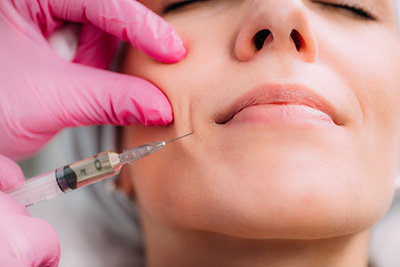
Published February 5, 2025
When you look at your face or body in the mirror and notice the signs of aging, have you ever tried to analyze what, precisely, is changing?
Let’s take a closer look at aging skin.
The first sign as we age – beginning as early as our 20s - is duller skin as our skin repair systems and cell turnover begin to slow. In the face, we start seeing fine lines, along with loss of volume in the cheek area. That, in turn, can make your undereye changes appear more noticeable. Additionally, we can begin to see pigmentation from sun damage.
The decline in production of collagen and elastin production means that skin will appear less tight, so we begin to see early wrinkles and thinner skin, especially in the undereye hollows, where we can start to see the blood vessels and increasing discoloration that brings “dark circles.”
Out of all these skin changes, volume loss is perhaps the most noticeable.
Volume loss is the gradual loss of fat and collagen in the skin. In addition, facial bone loss (boney resorption) contributes to volume changes. It is often responsible for signs of aging like wrinkles or sagging. As our facial tissues thin, lines become etched around the nose and mouth and cheeks can look flat or a little hollow.
The primary cause of volume loss is aging, but smoking and sun exposure – even certain medical conditions - can cause premature volume loss in our skin. The signs of volume loss include:
How do we address volume loss? Dermal fillers can replace lost volume to help smooth wrinkles, plump skin, and restore a more youthful appearance.
Dermal fillers are gel-like substances that we can inject beneath the skin to restore lost volume, soften creases, smooth lines and wrinkles, and enhance facial contours.
The first dermal filler was formulated using autologous fat. In the 1890s, German surgeon Franz Neuber harvested fat from a patient's upper arm and injected it into the face to repair cosmetic deformities.
Today’s dermal fillers are sometimes still formulated using autologous fat, but more commonly they utilize:
Millions use this facial rejuvenation treatment each year. It is a popular and cost-effective way to look younger without surgery or downtime.
Dermal Fillers are typed according to the primary substance used in formulating each filler. The following list is taken directly from the American Board of Cosmetic Surgery’s Injectable Fillers Guide:
Hyaluronic acid is a naturally occurring substance that is already found in your skin. It helps keep skin plump and hydrated. HA fillers are typically soft and gel-like. The results are temporary, lasting 6 months to several years, before the body gradually and naturally absorbs the particles. Most HA fillers are infused with lidocaine to help minimize discomfort during and after treatment.
Calcium hydroxylapatite is also a naturally occurring substance, found primarily in our bones. When used in a filler, the calcium particles are nearly microscopic and suspended in a smooth gel. The consistency of a CaHA filler is typically thicker than that of a hyaluronic acid filler. Calcium hydroxylapatite is also reported to help stimulate natural collagen production.
Poly-L-lactic acid is a biocompatible (meaning it is safe to use in the body), biodegradable synthetic substance. It has been used for many years in medical devices, such as dissolvable stitches. Poly-L-lactic acid products are technically classified as “collagen stimulators,” as their main mechanism to smooth fine lines is by helping your skin rebuild natural collagen—the product itself dissipates a few days after treatment. Poly-L-lactic acid is typically used to treat deeper facial wrinkles and volume loss, and results can last more than 2 years.
Polymethylmethacrylate (PMMA) is a synthetic, biocompatible substance that has been used in medicine for much of the last century. In dermal fillers, PMMA takes the form of a “microsphere” or tiny ball, that remains beneath the skin indefinitely (permanent) to provide continued support. PMMA fillers will also contain collagen, a naturally occurring substance in the skin that provides structure and firmness.
We have done our research and selected what we believe are the safest and most effective dermal fillers on today’s market. We also combine the use of dermal fillers with other treatment protocols we believe complement their effects. Your treatment plan will be customized to meet your individual needs and concerns – and we are eager to take the time to customize a plan of care just right for you.
Our Raleigh, NC team of aesthetic nurses, Meredith Harris, NP, Heather Shelton Roberts, RN, BSN, Amanda Tattersall, MSN, WHNP, and Natalie Walcott are amongst the country’s top specialists in skin rejuvenation. Together, they have administered safe and effective care for thousands of patients. We also offer special skincare consultations to evaluate your skin issues.
We can help put together a comprehensive skin health plan to help you love the skin you’re in. Call ☎ (919) 521-8282 or contact us online to schedule your consultation!